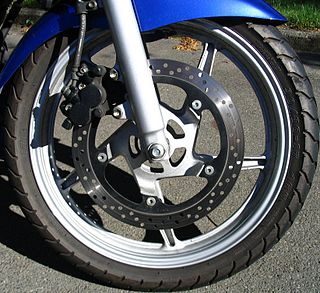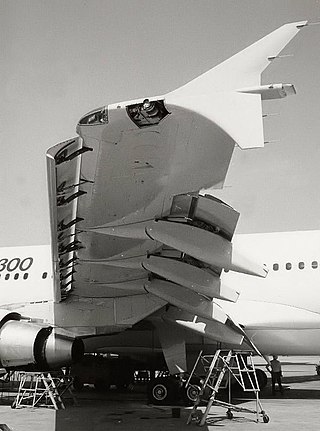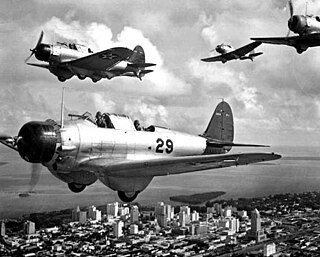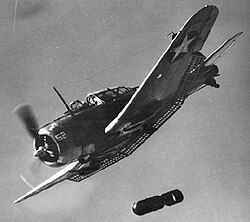
A brake is a mechanical device that inhibits motion by absorbing energy from a moving system. It is used for slowing or stopping a moving vehicle, wheel, axle, or to prevent its motion, most often accomplished by means of friction.

A dive bomber is a bomber aircraft that dives directly at its targets in order to provide greater accuracy for the bomb it drops. Diving towards the target simplifies the bomb's trajectory and allows the pilot to keep visual contact throughout the bomb run. This allows attacks on point targets and ships, which were difficult to attack with conventional level bombers, even en masse.

Aircraft flight control surfaces are aerodynamic devices allowing a pilot to adjust and control the aircraft's flight attitude.

The Arado Ar 240 was a German twin-engine, multi-role heavy fighter aircraft, developed for the Luftwaffe during World War II by Arado Flugzeugwerke. Its first flight was in 1940, but problems with the design hampered development, and it remained only marginally stable throughout the prototype phase. The project was eventually cancelled, with the existing airframes used for a variety of test purposes.

The Dornier Do 217 was a bomber used by the German Luftwaffe during World War II as a more powerful development of the Dornier Do 17, known as the Fliegender Bleistift. Designed in 1937 and 1938 as a heavy bomber but not meant to be capable of the longer-range missions envisioned for the larger Heinkel He 177, the Do 217's design was refined during 1939 and production began in late 1940. It entered service in early 1941 and by the beginning of 1942 was available in significant numbers.

The Northrop X-4 Bantam was a prototype small twinjet aircraft manufactured by Northrop Corporation in 1948. It had no horizontal tail surfaces, depending instead on combined elevator and aileron control surfaces for control in pitch and roll attitudes, almost exactly in the manner of the similar-format, rocket-powered Messerschmitt Me 163 of Nazi Germany's Luftwaffe. Some aerodynamicists had proposed that eliminating the horizontal tail would also do away with stability problems at fast speeds resulting from the interaction of supersonic shock waves from the wings and the horizontal stabilizers. The idea had merit, but the flight control systems of that time prevented the X-4 from achieving any success.

In aeronautics, a spoiler is a device which intentionally reduces the lift component of an airfoil in a controlled way. Most often, spoilers are plates on the top surface of a wing that can be extended upward into the airflow to spoil the streamline flow. By so doing, the spoiler creates a controlled stall over the portion of the wing behind it, greatly reducing the lift of that wing section. Spoilers differ from airbrakes in that airbrakes are designed to increase drag without disrupting the lift distribution across the wing span, while spoilers disrupt the lift distribution as well as increasing drag.

A flap is a high-lift device used to reduce the stalling speed of an aircraft wing at a given weight. Flaps are usually mounted on the wing trailing edges of a fixed-wing aircraft. Flaps are used to reduce the take-off distance and the landing distance. Flaps also cause an increase in drag so they are retracted when not needed.

In aeronautics, air brakes or speed brakes are a type of flight control surface used on an aircraft to increase the drag on the aircraft. Air brakes differ from spoilers in that air brakes are designed to increase drag while making little change to lift, whereas spoilers reduce the lift-to-drag ratio and require a higher angle of attack to maintain lift, resulting in a higher stall speed.

An aircraft fairing is a structure whose primary function is to produce a smooth outline and reduce drag.

The North American A-36 was the ground-attack/dive bomber version of the North American P-51 Mustang, from which it could be distinguished by the presence of rectangular, slatted dive brakes above and below the wings. A total of 500 A-36 dive bombers served in the Mediterranean and Southeast Asia theaters during World War II before being withdrawn from operational use in 1944.

The Learjet 25 is an American ten-seat, twin-engine, high-speed business jet aircraft manufactured by Learjet. It is a stretched version of the Learjet 24.

A flaperon on an aircraft's wing is a type of control surface that combines the functions of both flaps and ailerons. Some smaller kitplanes have flaperons for reasons of simplicity of manufacture, while some large commercial aircraft such as the Boeing 747, 767, 777, and 787 may have a flaperon between the flaps and aileron. The 787 has a configuration known as a SpoileFlaperon that combines the action of spoilers, flaps and ailerons into one control surface.

The Schempp-Hirth Mini Nimbus is a 15 Metre-class glider designed and built by Schempp-Hirth GmbH in the late 1970s.

The Northrop BT was an American two-seat, single-engine monoplane dive bomber built by the Northrop Corporation for the United States Navy. At the time, Northrop was a subsidiary of the Douglas Aircraft Company. While unsuccessful in its own right, the BT was subsequently redesigned into the Douglas SBD Dauntless, which would form the backbone of the Navy's dive bomber force.

The Breda Ba.201 was an Italian dive bomber designed during World War II, that never entered production.

The Curtiss XBTC was a prototype single-seat, single-engined torpedo/dive bomber developed during World War II for the United States Navy. Four aircraft were ordered, powered by two different engines, but the two aircraft to be fitted with the Wright R-3350 radial engine were cancelled in late 1942, leaving only the pair using the Pratt & Whitney R-4360 radial. By this time, Curtiss Aircraft was overwhelmed with work and the Navy gave the XBTC-2 prototypes a low priority which delayed progress so the first flight did not take place until the beginning of 1945. One aircraft crashed in early 1947 and the other was disposed of later that year.

A glider or sailplane is a type of glider aircraft used in the leisure activity and sport of gliding. This unpowered aircraft can use naturally occurring currents of rising air in the atmosphere to gain altitude. Sailplanes are aerodynamically streamlined and so can fly a significant distance forward for a small decrease in altitude.

The Fairey FC1 was a British airliner project of the 1930s. Although an order was placed for 14 FC1s in 1938, work was stopped by the outbreak of the Second World War, and no examples were built.
The performance data for landing an aircraft can be obtained from the aircraft's flight manual or pilot's operating handbook. It will state the distance required to bring the aircraft to a stop under ideal conditions, assuming the aircraft crosses the runway threshold at a height of 50 ft, at the correct speed. The actual landing performance of an aircraft is affected by many variables which must be taken into account.



















